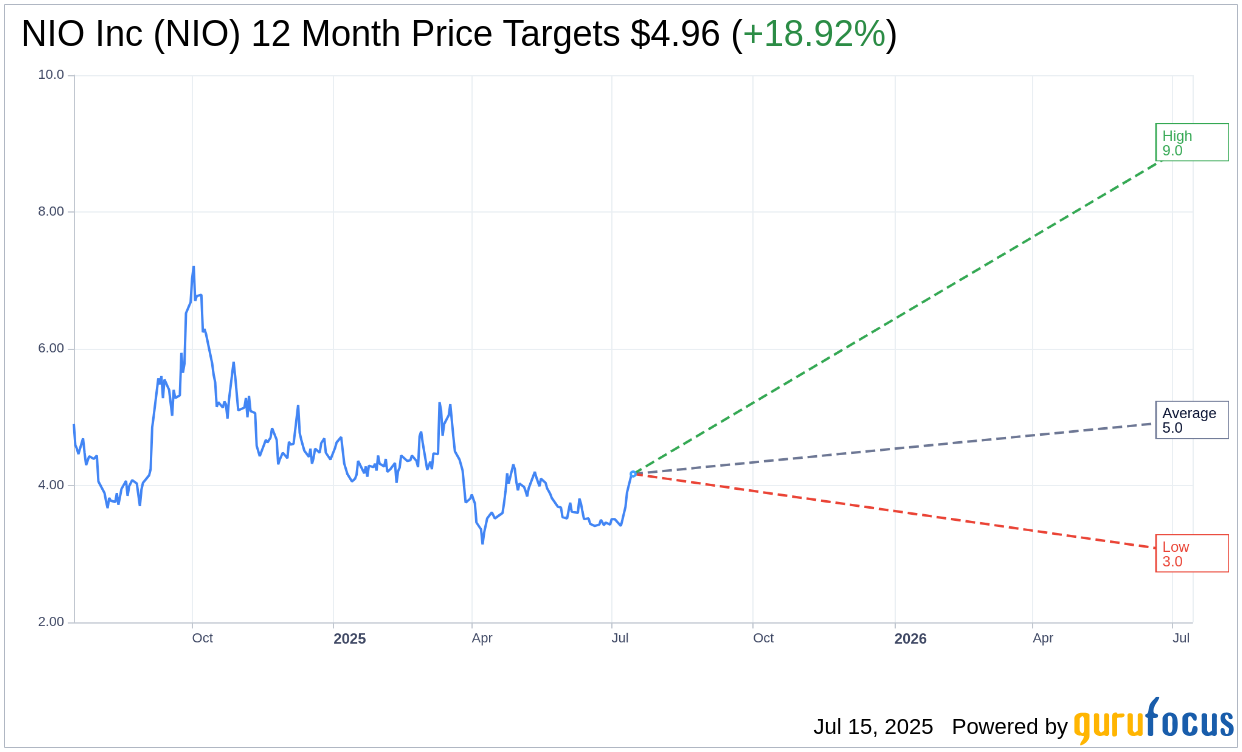Monday witnessed significant movement in the options market, with a total of 48.1 million contracts traded, leading to an increase in net open interest by 5.95 million calls and 5.43 million puts. Among the stocks experiencing notable growth in open interest was NIO (NIO, Financial), alongside several other major players.
One of the noteworthy developments for NIO (NIO, Financial) was the initiation of 36,000 new call options set to expire in November 2025, with a strike price of $3.50. This activity reflects a heightened market interest and strategic positioning among traders and investors related to the stock. The surge in option trading volume for NIO (NIO) underscores its prominence in the market's current landscape.
Wall Street Analysts Forecast

Based on the one-year price targets offered by 24 analysts, the average target price for NIO Inc (NIO, Financial) is $4.96 with a high estimate of $9.02 and a low estimate of $3.01. The average target implies an upside of 18.92% from the current price of $4.17. More detailed estimate data can be found on the NIO Inc (NIO) Forecast page.
Based on the consensus recommendation from 24 brokerage firms, NIO Inc's (NIO, Financial) average brokerage recommendation is currently 2.5, indicating "Outperform" status. The rating scale ranges from 1 to 5, where 1 signifies Strong Buy, and 5 denotes Sell.
Based on GuruFocus estimates, the estimated GF Value for NIO Inc (NIO, Financial) in one year is $12.03, suggesting a upside of 188.49% from the current price of $4.17. GF Value is GuruFocus' estimate of the fair value that the stock should be traded at. It is calculated based on the historical multiples the stock has traded at previously, as well as past business growth and the future estimates of the business' performance. More detailed data can be found on the NIO Inc (NIO) Summary page.
NIO Key Business Developments
Release Date: June 03, 2025
- Total Revenue: RMB12 billion, up 21.5% year-over-year, down 38.9% quarter-over-quarter.
- Vehicle Sales: RMB9.9 billion, up 18.6% year-over-year, down 43.1% quarter-over-quarter.
- Other Sales: RMB2.1 billion, up 37.2% year-over-year, down 5.9% quarter-over-quarter.
- Vehicle Margin: 10.2%, compared to 9.2% in Q1 last year and 13.1% last quarter.
- Overall Gross Margin: 7.6%, compared to 4.9% in Q1 last year and 11.7% last quarter.
- R&D Expenses: RMB3.2 billion, up 11.1% year-over-year, down 12.5% quarter-over-quarter.
- SG&A Expenses: RMB4.4 billion, up 46.8% year-over-year, down 9.8% quarter-over-quarter.
- Loss from Operations: RMB6.4 billion, up 19% year-over-year, up 6.4% quarter-over-quarter.
- Net Loss: RMB6.8 billion, increased year-over-year, decreased 5.1% quarter-over-quarter.
- Vehicle Deliveries: 42,094 units, up 4.1% year-over-year.
- Q2 Delivery Guidance: Between 72,000 and 35,000, representing 25.5% to 30.7% growth year-over-year.
For the complete transcript of the earnings call, please refer to the full earnings call transcript.
Positive Points
- NIO Inc (NIO, Financial) delivered 42,094 smart EVs in Q1 2025, marking a 4.1% year-over-year increase.
- The company launched and delivered new models including the ES6, EC6, ET5, and ET5T, which are expected to drive significant growth in Q2.
- NIO Inc (NIO) achieved year-over-year growth in both vehicle gross margin and overall gross margin due to cost reduction efforts.
- The NIO brand's ET9 surpassed BMW 7 Series and Audi A8 in China, marking a breakthrough for a Chinese brand in the premium executive segment.
- NIO Inc (NIO) raised over HKD4 billion in a share offering in Hong Kong, attracting global long-term investors.
Negative Points
- Total revenues decreased 38.9% quarter-over-quarter, reflecting a seasonal impact on deliveries.
- Vehicle margin decreased to 10.2% from 13.1% in the previous quarter due to increased manufacturing costs per unit.
- The company reported a net loss of RMB6.8 billion, showing an increase year-over-year.
- R&D expenses increased 11.1% year-over-year, driven by new product development and increased personnel costs.
- SG&A expenses rose 46.8% year-over-year, primarily due to increased personnel costs and sales and marketing activities.
